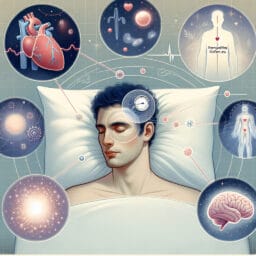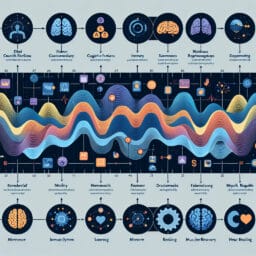
Understand Your Slumber: Defining Light Sleep
Table of Contents
- Introduction: The Importance of Understanding Sleep Stages
- Defining Sleep: An Overview
- What is Light Sleep?
- The Characteristics of Light Sleep
- The Role of Light Sleep in Overall Sleep Health
- How to Improve the Quality of Your Light Sleep
- Conclusion: Embrace Your Light Sleep
- Frequently Asked Questions
Introduction: The Importance of Understanding Sleep Stages
Did you know that the quality of your light sleep plays a pivotal role in feeling refreshed and rested upon waking? It’s true – even though light sleep is often overshadowed by its counterparts, deep sleep and REM sleep. As human beings, we cycle through various stages of sleep throughout the night, each serving a unique purpose for our body’s restoration. Light sleep, an integral part of these non-REM (NREM) stages, serves as the transition into deeper levels of slumber.
During this stage, while it may seem like not much is happening as compared to the more active REM or deepest NREM sleep stages, there are essential processes at work. Your heart rate slows down, motor behaviour motility decreases with depth increases – all setting up for reviving your body overnight. This stage helps establish adequate sleep depth and supports transitions between different phases in our complex yet intriguing cycle.
Aged individuals tend to spend more time in this pivotal phase which signifies how age affects our sleeping pattern considerably. Therefore it is crucial to create an environment conducive to high-quality light-sleeping since it makes up a significant portion of total sleeping time.
Moreover, understanding this intricate aspect of your nocturnal journey can help distinguish between merely being asleep and achieving high-quality restorative slumber that repairs tissues builds bone among other rejuvenating activities. Thus improving light-sleep quality could be key to maximizing overall wellness via better resting routines.
Defining Sleep: An Overview
Did you know that our bodies cycle through different sleep stages approximately five times each night? This cycling process is an intricate dance of neurochemistry and physiology, ensuring we get the restorative sleep needed to function optimally. A crucial player in this symphony of slumber is light sleep – the stage where we spend most of our total sleep time. This pivotal phase sets the tone for the night’s rhythm by establishing sleep depth, critical for transitioning between non-REM and REM stages.
Contrary to common perception, light sleep isn’t inferior to other stages; it plays a distinct role in rejuvenating human beings overnight. It’s during light sleep that your heart rate slows down and motor behaviour motility decreases, gently preparing your body for deeper phases of rest. Moreover, it’s responsive to external stimuli – a key safeguarding feature when potential danger arises around us.
Interestingly enough, age affects these patterns significantly. As we grow older, we tend to spend more time in light sleep while reducing time spent in deepest NREM and REM stages. Understanding these shifts can help optimize your sleeping environment conducive to high-quality sleep regardless of age- contributing positively towards feeling refreshed upon waking.
| Title | Defining Sleep: An Overview |
|---|---|
| Sleep Stages Cycle | Approximately five times each night |
| Main Sleep Stage | Light sleep |
| Function of Light Sleep | Establishes sleep depth, slows heart rate, decreases motor behaviour motility, prepares body for deeper sleep, responsive to external stimuli |
| Impact of Age on Sleep | Increases time in light sleep, reduces time in deepest NREM and REM stages |
| Optimization of Sleep | Understanding sleep shifts can help optimize sleeping environment conducive to high-quality sleep regardless of age |
| Image |
What is Light Sleep?
Unveiling the mysteries of our nocturnal journey, let’s delve deeper into understanding the light sleep stage. This is not just a transitory phase but indeed an integral part of sleep that contributes to the body’s self-restoration process. Although it may seem mild and passive as its name suggests, this stage has been recognized in sleep medicine for its pivotal role in establishing sleep depth, preparing us for more profound stages of non-REM and REM sleep.
Contrary to popular belief that deep NREM and REM stages are where all restorative magic happens, light sleep too bears responsibility for essential bodily functions. During this initial stage, human beings experience a decrease in both heart rate and motor behaviour motility – paving way for a calming plunge into deep restful slumbers. But here’s what distinguishes this phase from others: its heightened sensitivity to external stimuli. It means while deeply engrossed in the realm of dreams during other stages, if there’s any sudden noise or movement around you – it’s typically your light sleeping self that wakes up first as an instinctive protective response.
Evidently enough with age, we spend more time in light sleep than deepest NREM or REM–a clear sign how age affects our sleeping patterns markedly. So next time you think about improving your overall sleep quality or wonder why you awaken easily at night sounds or disturbances – remember it might be your crucial light-sleeping phase doing its job right!
The Characteristics of Light Sleep
Delving into the essential intricacies of sleep stages, one might be surprised to discover that it’s not only the deep or REM sleep that matter. Although often overlooked, light sleep plays a crucial role in our sleep cycle, acting as a pivotal phase in transitioning between various non-REM and REM stages. As human beings transition from wakefulness to slumber, they first enter the stage of light sleep characterized by a decrease in heart rate and motor behaviour motility which signifies depth increases.
Light sleep is more than just a bridge to deeper stages; it’s an active participant in maintaining our overall health and wellbeing. It helps establish the right environment conducive for deeper rest by creating an appropriate level of sleep depth. This aspect is critical as it prepares our body to repair and regrow tissues, build bone, strengthen immunity – all while we stay nestled comfortably within our dreams. Moreover, during this stage, we are responsive to external stimuli which acts as a safeguarding mechanism against potential threats.
The duration spent in this stage varies among individuals with age being a significant factor; older adults tend to spend more time in light sleep compared to deepest NREM or REM stages. Therefore understanding these nuances can help us optimize our sleeping environments for high-quality restorative slumber — an important step towards waking up refreshed and feeling rested every morning!
| Characteristic | Description |
|---|---|
| Role in the Sleep Cycle | Light sleep acts as a transitioning phase between various non-REM and REM stages. It also helps establish an environment conducive for deeper sleep. |
| Physical Changes | Characterized by a decrease in heart rate and motor behaviour motility. This signifies that sleep depth is increasing. |
| Benefits | Helps our body to repair and regrow tissues, build bone, and strengthen immunity. Also makes us responsive to external stimuli as a safeguarding mechanism against potential threats. |
| Duration | The time spent in light sleep varies among individuals. Age is a significant factor; older adults tend to spend more time in light sleep compared to deepest NREM or REM stages. |
| Impact on Quality of Sleep | Understanding the characteristics and benefits of light sleep can help optimize sleeping environments for high-quality, restorative slumber. |
The Role of Light Sleep in Overall Sleep Health
Did you know that light sleep, a pivotal phase in our sleep cycle, forms an integral part of achieving high-quality sleep? While often overshadowed by REM and deep non-REM stages, light sleep serves as the foundation for establishing sleep depth. As human beings transition from wakefulness into slumber, they enter this stage characterized by a decrease in heart rate and motor behaviour motility – signs indicating increasing depth of rest. It’s not just a transitory phase; it’s during this period that our body repairs tissues, builds bone and strengthens immunity. Parallelly, we’re also responsive to external stimuli in this stage which acts as our defense mechanism against potential dangers around us – an intriguing balance between relaxation and alertness maintained by our bodies! Surprisingly enough with age, we tend to spend more time in light sleep – a clear indication of how age affects our sleeping patterns. Thus understanding its role can dramatically improve your overall quality of sleep – paving the way towards feeling refreshed and rested every morning!
How to Improve the Quality of Your Light Sleep
As we delve further into understanding light sleep, we grasp its crucial role in the symphony of our nocturnal journey. A surprising fact is that the stage of light sleep, often underestimated, forms a considerable chunk of our total sleep time. This pivotal phase in the sleep cycle is significant in setting up an environment conducive to deep slumber by managing heart rate and decreasing motor behaviour motility; signs indicative of increasing depth of rest. It’s during this period that your body repairs and regrows tissues or builds bone – essential processes for overall health maintenance. Moreover, being responsive to external stimuli during this phase acts as a safeguard against potential threats around us.
Sleep patterns are deeply influenced by age as well; older adults tend to spend more time in the stage of light sleep than deepest NREM or REM stages—a clear expression how age affects our sleeping habits. Therefore, recognizing these shifts can help distinguish between mere resting and achieving high-quality sleep – a prerequisite for waking up feeling refreshed every morning!
To amplify your light sleep quality, consider creating an environment favourable for high-quality slumber—dimming lights earlier in the evening, maintaining a cool room temperature or investing in blackout curtains could be beneficial steps.
Remember, enhancing your understanding and consequent management of this often overlooked yet vital stage can significantly improve your overall wellness – helping you wake up feeling rested every day! So what are you waiting for? Embrace the power of light-sleeping today!
Conclusion: Embrace Your Light Sleep
Did you know that the stage of light sleep, often underestimated, forms a significant part of our total sleep time? This pivotal phase in the sleep cycle is essential in setting up an environment conducive to deep slumber. It’s during this period that remarkable transformations occur within our bodies as they repair and regrow tissues, build bone and strengthen immunity. A fascinating characteristic of this stage is its sensitivity to external stimuli, serving as a safeguard against potential threats around us; a delicate balance between relaxation and alertness maintained by our bodies for optimal wellbeing. Interestingly enough with age, we tend to spend more time in the stage of light sleep than deepest NREM or REM stages—a clear expression how age affects our sleeping habits. Recognizing these shifts can help distinguish between mere resting and achieving high-quality sleep – a prerequisite for waking up feeling refreshed every morning! Therefore it’s encouraged to give due importance to your light sleep stage — enhancing it could significantly contribute towards better quality rest overall.


